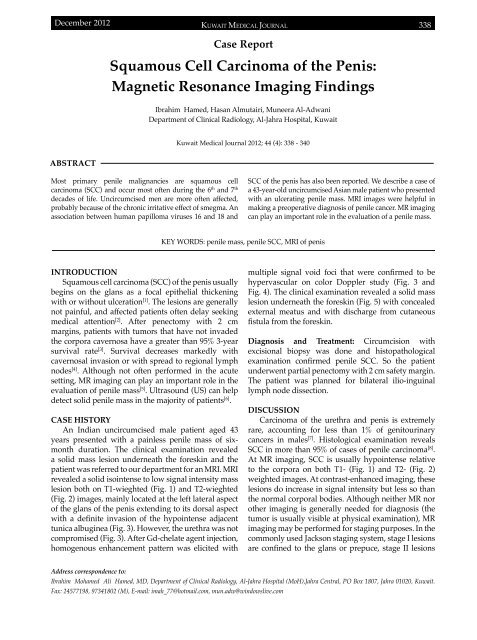Vol 44 # 4 December 2012 - Kma.org.kw
Vol 44 # 4 December 2012 - Kma.org.kw
Vol 44 # 4 December 2012 - Kma.org.kw
You also want an ePaper? Increase the reach of your titles
YUMPU automatically turns print PDFs into web optimized ePapers that Google loves.
<strong>December</strong> <strong>2012</strong><br />
KUWAIT MEDICAL JOURNAL 338<br />
Case Report<br />
Squamous Cell Carcinoma of the Penis:<br />
Magnetic Resonance Imaging Findings<br />
Ibrahim Hamed, Hasan Almutairi, Muneera Al-Adwani<br />
Department of Clinical Radiology, Al-Jahra Hospital, Kuwait<br />
Kuwait Medical Journal <strong>2012</strong>; <strong>44</strong> (4): 338 - 340<br />
ABSTRACT<br />
Most primary penile malignancies are squamous cell<br />
carcinoma (SCC) and occur most often during the 6 th and 7 th<br />
decades of life. Uncircumcised men are more often affected,<br />
probably because of the chronic irritative effect of smegma. An<br />
association between human papilloma viruses 16 and 18 and<br />
SCC of the penis has also been reported. We describe a case of<br />
a 43-year-old uncircumcised Asian male patient who presented<br />
with an ulcerating penile mass. MRI images were helpful in<br />
making a preoperative diagnosis of penile cancer. MR imaging<br />
can play an important role in the evaluation of a penile mass.<br />
KEY WORDS: penile mass, penile SCC, MRI of penis<br />
INTRODUCTION<br />
Squamous cell carcinoma (SCC) of the penis usually<br />
begins on the glans as a focal epithelial thickening<br />
with or without ulceration [1] . The lesions are generally<br />
not painful, and affected patients often delay seeking<br />
medical attention [2] . After penectomy with 2 cm<br />
margins, patients with tumors that have not invaded<br />
the corpora cavernosa have a greater than 95% 3-year<br />
survival rate [3] . Survival decreases markedly with<br />
cavernosal invasion or with spread to regional lymph<br />
nodes [4] . Although not often performed in the acute<br />
setting, MR imaging can play an important role in the<br />
evaluation of penile mass [5] . Ultrasound (US) can help<br />
detect solid penile mass in the majority of patients [6] .<br />
CASE HISTORY<br />
An Indian uncircumcised male patient aged 43<br />
years presented with a painless penile mass of sixmonth<br />
duration. The clinical examination revealed<br />
a solid mass lesion underneath the foreskin and the<br />
patient was referred to our department for an MRI. MRI<br />
revealed a solid isointense to low signal intensity mass<br />
lesion both on T1-wieghted (Fig. 1) and T2-wieghted<br />
(Fig. 2) images, mainly located at the left lateral aspect<br />
of the glans of the penis extending to its dorsal aspect<br />
with a definite invasion of the hypointense adjacent<br />
tunica albuginea (Fig. 3). However, the urethra was not<br />
compromised (Fig. 3). After Gd-chelate agent injection,<br />
homogenous enhancement pattern was elicited with<br />
multiple signal void foci that were confirmed to be<br />
hypervascular on color Doppler study (Fig. 3 and<br />
Fig. 4). The clinical examination revealed a solid mass<br />
lesion underneath the foreskin (Fig. 5) with concealed<br />
external meatus and with discharge from cutaneous<br />
fistula from the foreskin.<br />
Diagnosis and Treatment: Circumcision with<br />
excisional biopsy was done and histopathological<br />
examination confirmed penile SCC. So the patient<br />
underwent partial penectomy with 2 cm safety margin.<br />
The patient was planned for bilateral ilio-inguinal<br />
lymph node dissection.<br />
DISCUSSION<br />
Carcinoma of the urethra and penis is extremely<br />
rare, accounting for less than 1% of genitourinary<br />
cancers in males [7] . Histological examination reveals<br />
SCC in more than 95% of cases of penile carcinoma [8] .<br />
At MR imaging, SCC is usually hypointense relative<br />
to the corpora on both T1- (Fig. 1) and T2- (Fig. 2)<br />
weighted images. At contrast-enhanced imaging, these<br />
lesions do increase in signal intensity but less so than<br />
the normal corporal bodies. Although neither MR nor<br />
other imaging is generally needed for diagnosis (the<br />
tumor is usually visible at physical examination), MR<br />
imaging may be performed for staging purposes. In the<br />
commonly used Jackson staging system, stage I lesions<br />
are confined to the glans or prepuce, stage II lesions<br />
Address correspondence to:<br />
Ibrahim Mohamed Ali Hamed, MD, Department of Clinical Radiology, Al-Jahra Hospital (MoH),Jahra Central, PO Box 1807, Jahra 01020, Kuwait.<br />
Fax: 24577198, 97341802 (M), E-mail: imah_77@hotmail.com, mun.adw@windowslive.com
















